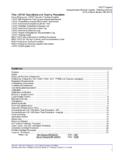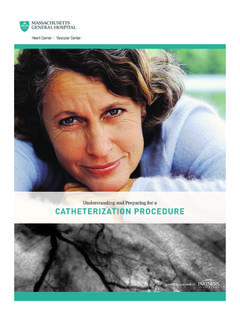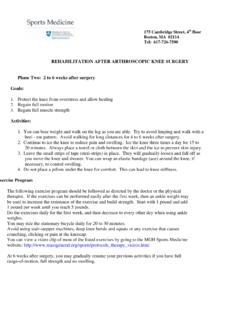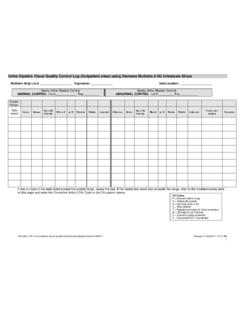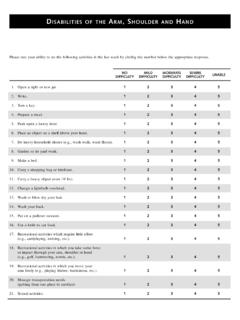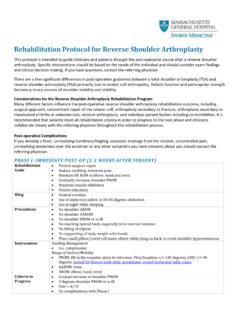Transcription of Rehabilitation Protocol for Total Shoulder Arthroplasty ...
1 Rehabilitation Protocol for Total Shoulder Arthroplasty and Hemiarthroplasty This Protocol is intended to guide clinicians and patients through the post-operative course after a Total Shoulder Arthroplasty (TSA) and hemiarthroplasty. Specific interventions should be based on the needs of the individual and should consider exam findings and clinical decision making. If you have questions, contact the referring physician. Considerations for the Total Shoulder Arthroplasty and Hemiarthroplasty Rehabilitation Program Many different factors influence the post-operative Rehabilitation outcome, including surgical approach, concomitant repair of the rotator cuff, Arthroplasty secondary to fracture, Arthroplasty secondary to rheumatoid arthritis or osteonecrosis, and individual patient factors including co-morbidities. It is recommended that patients meet all Rehabilitation criteria in order to progress to the next phase and clinicians collaborate closely with the referring physician throughout the Rehabilitation process.
2 Post-operative Complications If you develop a fever, unresolving numbness/tingling, excessive drainage from the incision, uncontrolled pain or any other symptoms you have concerns about you should contact the referring physician. PHAS E I : IM MEDI AT E POST-OP (0-3 W E EKS AF TE R S UR GER Y) Rehabilitation Goals Protect surgical repair Reduce swelling, minimize pain Maintain UE ROM in elbow, hand and wrist Gradually increase Shoulder PROM Minimize muscle inhibition Patient education Sling Neutral rotation Use of abduction pillow in 30-45 degrees abduction Use at night while sleeping Precautions No Shoulder AROM No reaching behind back, especially in to internal rotation No excessive Shoulder external rotation or abduction No lifting of objects No supporting of body weight with hands Place small pillow/towel roll under elbow while lying on back to avoid Shoulder hyperextension Intervention Swelling Management Ice, compression Range of motion/Mobility PROM.
3 ER </= 30 degrees in the scapular plane, IR to belt line in scapular plane, Flex/Scaption to tolerance, ABD </= 90 degrees, pendulums, seated GH flexion table slide, seated horizontal table slide AAROM: Active assistive Shoulder flexion AROM: elbow, hand, wrist Strengthening (Week 2) Periscapular: scap retraction, prone scapular retraction, standing scapular setting, supported scapular setting, inferior glide, low row Ball squeeze Criteria to Progress >/= 50% Shoulder PROM flex, scaption as compared to contralateral side </= 90 degrees of Shoulder ABD PROM </= 30 degrees of Shoulder ER PROM in scapular plane >/= 70 degrees of IR PROM in scapular plane M as sa c h u se tt s G en era l H o spi ta l S po rts M e di ci ne 2 Palpable muscle contraction felt in scapular musculature Pain < 4/10 No complications with Phase I PHAS E I I.
4 IN TER ME DIATE POS T-OP (4-6 WEE KS AF TE R S UR GERY) Rehabilitation Goals Continue to protect surgical repair Reduce swelling, minimize pain Gradually increase Shoulder PROM Minimize substitution patterns with AROM and AAROM Improve periscapular muscle activation/strength Initiate RTC (external rotators) activation Patient education Sling Use at night while sleeping Gradually start weaning sling over the next two weeks during the day Precautions No excessive Shoulder external rotation or abduction No lifting of objects heavier than a coffee cup No supporting of body weight with hands Place small pillow/towel roll under elbow while lying on back to avoid Shoulder hyperextension Intervention *Continue with Phase I interventions Range of motion/Mobility PROM: Full with exception of ER </= 30 degrees in scapular plane and </= 90 degrees ABD AAROM: Shoulder flexion with cane, cane external rotation stretch, washcloth press, seated Shoulder elevation with cane AROM: supine flexion, salutes, supine punch Strengthening Rotator cuff: external rotation isometrics Periscapular: Row on physioball, serratus punches Elbow.
5 Biceps curl, resistance band bicep curls and triceps Motor control ER in scaption and Flex 90-125 (rhythmic stabilization) Stretching Sidelying horizontal ADD Criteria to Progress >/=75% Shoulder PROM flex, scaption, as compared to contralateral side >/=75% Shoulder PROM IR in scapular plane as compared to contralateral side 30 degrees of Shoulder PROM ER in scapular plane 90 degrees of Shoulder PROM ABD Minimal substitution patterns with AAROM AROM Shoulder elevation to 100 degrees with minimal substitution patterns Pain < 4/10 No complications with Phase II PHAS E I II: I NTE RME DIATE POS T-OP CON TD (7-8 W EE KS AFT ER S URGE RY) Rehabilitation Goals Do not overstress healing tissue (especially the anterior capsule) Minimize pain Maintain PROM Improve AROM Progress periscapular and RTC strength Return to full functional activities Patient education Sling Discontinue Precautions No lifting of heavy objects (>10 lbs) Intervention *Continue with Phase I-II interventions Range of motion/Mobility Full ROM in all planes AAROM: incline table slides, ball roll on wall, wall climbs, pulleys AROM: seated scaption, seated flexion, supine forward elevation with elastic resistance to 90 deg M as sa c h u se tt s G en era l H o spi ta l S po rts M e di ci ne 3 Strengthening Rotator cuff.
6 Internal rotation isometrics, side-lying external rotation, Standing external rotation w/ resistance band, standing internal rotation w/ resistance band, internal rotation, external rotation, Periscapular: Resistance band Shoulder extension, resistance band seated rows, rowing, lawn mowers, robbery Motor control IR/ER and Flex 90-125 (rhythmic stabilization) Quadruped alternating isometrics and ball stabilization on wall PNF-D1 diagonal lifts, PNF-D2 diagonal lifts Stretching IR behind back with towel, sidelying horizontal ADD, sleeper stretch, triceps and lats Criteria to Progress Minimal to no substitution patterns with Shoulder AROM Pain < 4/10 PHAS E IV : T RANS ITI ONAL POST-OP (9-1 1 WE E KS AFT ER SURGERY) Rehabilitation Goals Do not overstress healing tissue (especially the anterior capsule) Maintain pain-free PROM Continue improving AROM Improve dynamic Shoulder stability Gradually restore Shoulder strength and endurance Precautions No lifting of heavy objects (> 10 lbs) Avoid exercises that put stress on the anterior Shoulder capsule (ie: Shoulder ER above 80 degrees of ABD) Intervention *Continue with Phase II-III interventions Range of motion/mobility Full ROM in all planes Strengthening Rotator cuff: increase resistance rotator cuff exercise Periscapular.
7 Push-up plus on knees, W exercise, resistance band Ws, dynamic hug, resistance band dynamic hug, prone Shoulder extension Is, resistance band forward punch, forward punch, tripod, pointer Motor control Resistance band PNF pattern, PNF D1 diagonal lifts w/ resistance, diagonal-up, diagonal-down Wall slides w/ resistance band Criteria to Progress Supine AROM Flex >/=140 degrees Supine AROM ABD >/=120 degrees Supine AROM ER in scapular plane >/= 60 degrees Supine AROM IR in scapular plane >/= 70 degrees AROM Shoulder elevation to 120 degrees with minimal substitution patterns Performs all exercises demonstrating symmetric scapular mechanics Pain < 2/10 PHAS E V: ADV AN CE D ST RE NGT HEN ING POST-OP (12-1 6 WE EKS AF TE R S UR GER Y) Rehabilitation Goals Maintain pain-free ROM Improve Shoulder strength and endurance Enhance functional use of upper extremity Intervention *Continue with Phase II-IV interventions Strengthening Rotator cuff: External rotation at 90 degrees, internal rotation at 90 degrees, resistance band standing external rotation at 90 degrees, resistance band standing internal rotation at 90 degrees Periscapular.
8 T and Y, T exercise, push-up plus knees extended, wall push up Motor Control Progress ball stabilization on wall to overhead alternating isometrics/rhythmic stabilization M as sa c h u se tt s G en era l H o spi ta l S po rts M e di ci ne 4 Criteria to Progress Clearance from MD and ALL milestone criteria have been met Maintains pain-free PROM and AROM Performs all exercises demonstrating symmetric scapular mechanics QuickDASH PENN Return-to-Sport For the recreational or competitive athlete, return-to-sport decision making should be individualized and based upon factors including level of demand on the upper extremity, contact vs non-contact sport, frequency of participation, etc. We encourage close discussion with the referring surgeon prior to advancing to a return-to-sport Rehabilitation program. Revised December 2018 Contact Please email with questions specific to this Protocol References Angst, F, Goldhahn, J, et al.
9 Responsiveness of six outcome assessment instruments in Total Shoulder Arthroplasty . Arthritis & Rheumatism. 2008. 59 (3): 391-398. Garcia, GH, Liu, JN, et al. High satisfaction and return to sports after Total Shoulder Arthroplasty in patients aged 55 years and younger. AJSM. 2017. 45 (7): 1664-1669. Gaunt BW, McCluskey GM, Uhl TL. An electromyographic evaluation of subdividing active-assistive Shoulder elevation exercises. Sports Health. 2010. 2 (5): 424-432. Hughes, M, Neer II, CS. Glenohumeral joint replacement and postoperative Rehabilitation . Physical Therapy. 1975. 55(8): 850-858. Kibler, , Sciascia, A. D., Uhl, T. L., et al. Electromyographic analysis of specific exercises for scapular control in early phases of Shoulder Rehabilitation . The American Journal of Sports Medicine. 2008. 36(9): p. 1789-1798. Knesek M, Brunfeldt, A, et al. Patterns of strain and the determination of the safe arc of motion after subscapularis repair-a biomechanical study.
10 Journal of Orthopaedic Research. 2016. 34: 518-524. Piasecki, DP, Nicholson, GP. Tears of the subscapularis tendon in athletes-diagnosis and repair techniques. Clin Sports Med. 2008. 27: 731-745. Uhl TL, Muir TA, et al. Electromyographical assessment of passive, active assistive, and active Shoulder Rehabilitation exercises. PM R. 2010. 2: 132-141. Wilcox III , Arslanian , Millett Rehabilitation following Total Shoulder Arthroplasty . JOSPT. 2005. 35 (12): 821-837 Wolff. AL, Rosenzweig, L. Anatomical and biomechanical framework for Shoulder Arthroplasty Rehabilitation . Journal of Hand Therapy. 2017. 30: 167-174. Wright, T, Easley, T, et al. Shoulder Arthroplasty and its effect on strain in the subscapularis muscle. Clinical Biomechanics. 2015. 30: 373-376. Zarkadas , Throckmorton T., et al. Patient reported activities after Shoulder replacement: Total and hemiarthroplasty.


